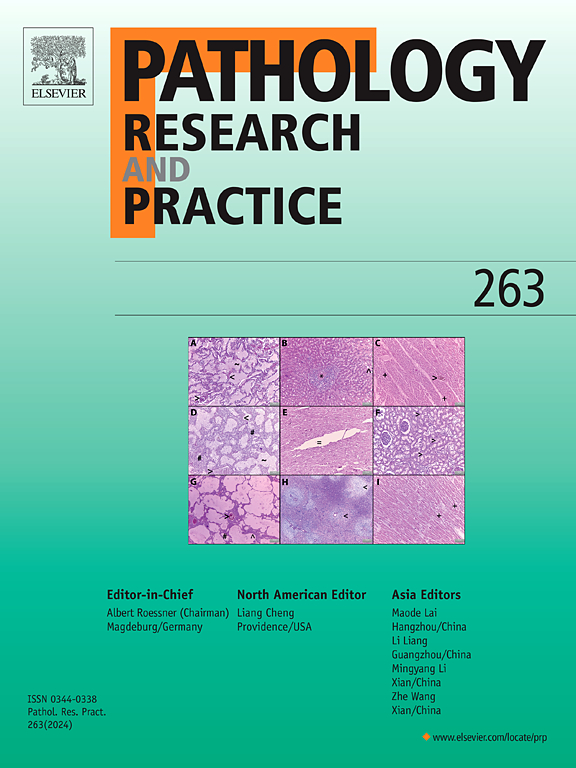Estrogen receptor subtypes and survival outcomes in non-small cell lung cancer
IF 2.9
4区 医学
Q2 PATHOLOGY
引用次数: 0
Abstract
Aim
Estrogen receptors (ERs), ERα and ERβ, are frequently detected in lung cancers, yet their prognostic impact on non-small cell lung cancer (NSCLC) outcomes remains uncertain. This study aims to assess the pooled prevalence and prognostic significance of ERα and ERβ in NSCLC, with a focus on gender differences.
Methods
We performed a systematic review and meta-analysis, identifying studies from major databases, including PubMed, Cochrane Library, and Embase, that reported ERα and ERβ expression and survival outcomes in NSCLC. Hazard ratios (HRs) with 95 % confidence intervals (CIs) were calculated using random-effects models to assess associations with overall survival (OS). Heterogeneity was evaluated using the I² statistic, and publication bias was examined with funnel plots. Statistical analyses were conducted in R (version 4.3.0) utilizing the 'meta' package."
Results
Eighteen studies comprising 3842 patients met the inclusion criteria. ERα positivity was observed in 32 % of cases, whereas ERβ positivity was found in 60 %. ERα positivity in males was 53 %, and in females was 47 %. Meanwhile, ERβ positivity was seen in 49 % of males and 51 % of females. The pooled HR for ERα was 1.17 (95 % CI: 0.60–2.27), indicating no significant association with OS. However, ERβ positivity was linked to a statistically significant reduction in mortality risk (HR 0.85, 95 % CI: 0.72–0.99, p = 0.04). Subgroup analysis demonstrated a higher mortality hazard in males compared to females (HR 1.42, 95 % CI: 1.22–1.67, p < 0.005).
Conclusion
NSCLC exhibits high rates of ERβ expression, which is linked to improved survival outcomes. In contrast, ERα expression is less prevalent, and its prognostic significance remains uncertain. These findings underscore ERβ as a promising therapeutic target in NSCLC, emphasizing the need for continued research into hormone-targeted treatments in lung cancer, especially given that approximately 50 % of both male and female patients with NSCLC express ERβ.
目的雌激素受体(ER)、ERα和ERβ经常在肺癌中被检测到,但它们对非小细胞肺癌(NSCLC)预后的影响仍不确定。本研究旨在评估ERα和ERβ在NSCLC中的总体患病率和预后意义,重点关注性别差异。方法我们进行了一项系统性回顾和荟萃分析,从PubMed、Cochrane Library和Embase等主要数据库中筛选出报告了ERα和ERβ在NSCLC中的表达和生存结果的研究。采用随机效应模型计算危害比(HRs)和95%置信区间(CIs),以评估与总生存期(OS)的关系。使用I²统计量评估异质性,使用漏斗图检查发表偏倚。统计分析在 R(4.3.0 版)中使用'meta'软件包进行。ERα阳性病例占32%,而ERβ阳性病例占60%。男性ERα阳性率为53%,女性为47%。同时,ERβ阳性的男性占 49%,女性占 51%。ERα的汇总HR为1.17(95% CI:0.60-2.27),表明与OS无明显关系。然而,ERβ阳性与死亡率风险的显著降低有统计学关系(HR 0.85,95 % CI:0.72-0.99,p = 0.04)。亚组分析显示,男性死亡率高于女性(HR 1.42,95 % CI:1.22-1.67,p = 0.005)。相比之下,ERα的表达较少,其预后意义仍不确定。这些发现强调了ERβ是NSCLC的一个有希望的治疗靶点,强调了继续研究肺癌激素靶向治疗的必要性,特别是考虑到大约50%的男性和女性NSCLC患者都表达ERβ。
本文章由计算机程序翻译,如有差异,请以英文原文为准。
求助全文
约1分钟内获得全文
求助全文
来源期刊
CiteScore
5.00
自引率
3.60%
发文量
405
审稿时长
24 days
期刊介绍:
Pathology, Research and Practice provides accessible coverage of the most recent developments across the entire field of pathology: Reviews focus on recent progress in pathology, while Comments look at interesting current problems and at hypotheses for future developments in pathology. Original Papers present novel findings on all aspects of general, anatomic and molecular pathology. Rapid Communications inform readers on preliminary findings that may be relevant for further studies and need to be communicated quickly. Teaching Cases look at new aspects or special diagnostic problems of diseases and at case reports relevant for the pathologist''s practice.

 求助内容:
求助内容: 应助结果提醒方式:
应助结果提醒方式:


